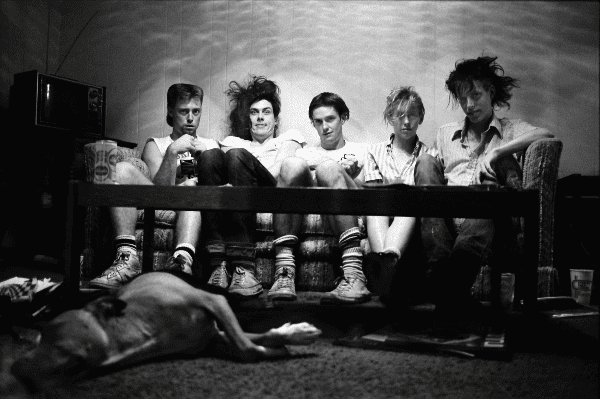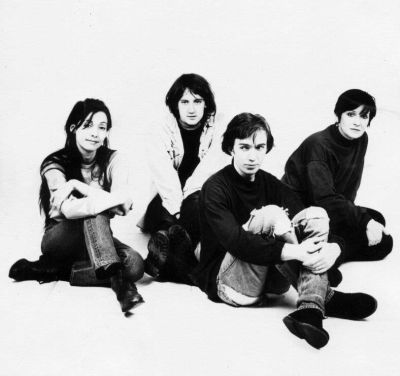We are pleased to announce that Matador Records will reissue a number of key catalog titles by legendary Texas band, The Butthole Surfers, including classic albums and EPs recorded during the band’s strange, grotesque, and ultimately unparalleled first decade. All of the records have been remastered under supervision from the group.

Today, remastered audio of the first three releases in the series – Psychic…Powerless…Another Man’s Sac, Rembrandt Pussyhorse, and PCPPEP – have been made available on streaming services, with vinyl to follow on March 22. Pre-orders are available HERE. You can also watch a new video for the song ‘Butthole Surfer’ featuring rarely seen photographs of the band shot by Gail Butensky during the 1980s. Further titles will follow in autumn.
The Butthole Surfers were formed in 1981 by vocalist Gibby Haynes and guitarist Paul Leary. Drummer King Coffey joined in 1983. Together, they have remained the band’s three constant members across various recording sessions and touring incarnations.
Byron Coley on The Butthole Surfers:
More than four decades after the fact, I still remember walking out of my live introduction to the Buttholes in a state of happy confoundment. By 1982 there were already plenty of bands who’d ostensibly begun as part of the American hardcore scene but were now headed in other directions. One such unit was Austin’s Big Boys, whose mix of gender-bending skatepunk and funk readymades were addictively brilliant. We went to see them at L.A.’s Grandia Room with low expectations for openers, the Butthole Surfers, who we’d figured were just another thrash band from Texas with a “shock” moniker.
The Buttholes had already begun their set by the time we got there, and it was immediately evident their sonic approach was far from what we’d expected. Some of their songs resembled a better, weirder version of the Dead Kennedys, but the comprehendible snippets of lyrics sounded great as hell – “There’s a time to fuck and a time to crave/But the Shah sleeps in Lee Harvey’s grave!” And the singer and guitarist looked like they were competing in the nuts boy sweepstakes. Even with the Grandia Room’s impossible sight-lines, the band made a real impression. I asked Mike Watt what he knew about them and he just said they were, “out there.” Which I took as a good sign.
When their records started arriving, I bought them even though they were on Jello B’s label (which I usually boycotted). ‘PCPPEP’ (actually recorded after the protean version of ‘Another Man’s Sac’) sounded more whacked-out than the studio record that preceded it, and was also the first to feature the power of the band’s classic two drummer line-up (King Coffey and Teresa Taylor). The synchronized percussive brutarianism of this pair (falsely rumored to be siblings) provided the perfect base for the unhinged blurt of the guitars and vocals then being shared by Gibby Haynes and Paul Leary. We didn’t manage to see the Buttholes again until they played the East Coast in ’84, by which time a few bassists had come and gone, and the band had evolved into full freakout mode.
The early-mid ’80s had their share of insane combos – The Birthday Party, Black Flag and Minor Threat had the raw power to melt your mind in seconds. SWANS, Einsturzende Neubauten and Big Black created enough overwhelming sonic pressure their sounds might actually flatten you. And Sonic Youth displayed such a dizzyingly unpredictable mix of art, pop culture and violence you’d sometimes leave their shows drooling. The Buttholes shared elements with all of these groups, but added a wild psychedelic edge and a propensity for bizarre spectacle.
By the time they started touring to preview and then support the revamped version of ‘Psychic…Powerless…Another Man’s Sac’, the Buttholes’ live show was an berserk, evolving extravaganza of strobes, smoke, clothespins, naked dancing, bullhorns, raving lunacy and music that was as madly mind-blowing as that of any band who ever lived. ‘Another Man’s Sac’ was also wildly advanced over the previous records. Parts of the LP swaddled their punk edge inside so much oink and babble you almost couldn’t discern it, with other segments stretching out into a mutant form of garage blues, and others just swirling out of control.
This evolution continued on ‘Rembrandt Pussyhorse’, which featured a set of tunes for which the Buttholes’ rock-based form destruction was mixed with experimental, tape-mangling passages of many flavors. Haynes was handling all audible vocals by this point, and his mastery of post-tongue dynamism was finally in full flight. Meanwhile, their live shows became legendary examples of excess and derangement, and their music just kept getting louder and stranger and more savage. It was the diametric opposite of the hardcore scene from which it had emerged, which was heading in ever more codified and stylistically conservative directions.
This first batch of reissues is certain to raise the roof for a lot of people who thought they had a pretty good handle on the outer realms of the ’80s indie-rock scene. And while the recordings are not the fully immersive experience of the Buttholes in concert, you may still feel as though you’ve fallen down a rabbit hole the size of Texas itself.
This is the sound of the Butthole Surfers before they were name-checked by Kurt Cobain, and signed by Capitol in a frenzy to not-be-left-out of the indie-rock sweepstakes. Before they had an actual Billboard hit with “Pepper,” from their 1996 LP, ‘Electric Larryland’. Before people saw them as something like a progenitor for theatrically oddball outfits like the Flaming Lips and Animal Collective. The Buttholes’ early recordings for independent labels, and the shows they played throughout the 1980s, stand as pure exemplars of the most cussedly Dionysian vom ever spewed.
Yippie Yi Yo!





